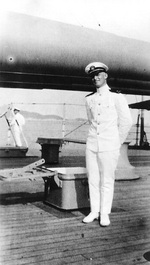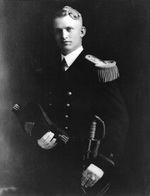Arleigh Burke
| Surname | Burke |
| Given Name | Arleigh |
| Born | 19 Oct 1901 |
| Died | 1 Jan 1996 |
| Country | United States |
| Category | Military-Sea |
| Gender | Male |
Contributor: C. Peter Chen
ww2dbaseArleigh Albert Burke was born in Boulder, Colorado, United States. On 8 Jun 1923, he graduated from the United States Naval Academy at Annapolis, Maryland, United States and was commissioned ensign in the United States Navy. He earned a Master of Science degree in Engineering at the University of Michigan. In 1939, he received his first command aboard the destroyer Mugford. At the start of WW2, he served at the Naval Gun Factory in Washington, DC, United States. In 1943, he was assigned to Destroyer Division 43 in the South Pacific as its commanding officer. He later served in a similar role with Destroyer Division 44, Destroyer Squadron 12, and Destroyer Squadron 23. He commanded the Destroyer Squadron 23 during the Bougainville landing operation in Nov 1943. He was known for pushing his crews to sail at high speeds, sometimes with the boiler pressure just below dangerous levels. While en route to a rendezvous point in Nov 1943 to intercept a "Tokyo Express" convoy, a boiler accident that involved one casualty limited his squadron to 31 knots, instead of the 34 knots they were capable of, hence earning him the nickname "31-Knot Burke". His squadron was able to intercept the "Tokyo Express" convoy despite the slower speed, sinking multiple destroyers in that convoy while also killing the Japanese commanding officer Kiyoto Kagawa; the engagement was later named Battle of Cape St. George.
ww2dbaseFor his service with Destroyer Squadron 21, Burke was awarded the Navy Distinguished Service Medal, the Navy Cross, and the Legion of Merit. The Navy Distinguished Service Medal citation noted his "indomitable fighting spirit and great personal courage contributed directly to the success of our forces in [the Pacific] and were in keeping with the highest traditions of the United States Naval Service."
ww2dbaseIn Mar 1944, Burke was promoted to the war time rank of commodore and assigned as the Chief of Staff to Admiral Marc Mitscher, Commander Fast Carrier Task Force 58, with his flag aboard carrier Bunker Hill. On 11 May 1945, while aboard Bunker Hill off Okinawa, he witnessed the attack on the carrier by two kamikaze aircraft. The attack killed 373 men and wounded 264 more. Three days later, the new flagship he had chosen was hit by another special attack aircraft. His successful crisis management results during the attacks earned him the Silver Star Medal and a Letter of Commendation. The citation of the Silver Star read
ww2dbaseWhile the Letter of Commendation noted that Burke, "with utter disregard for his personal safety,... efficiently organized the evacuation of endangered personnel. His courage together with his prompt and efficient action was responsible for saving these men...."
ww2dbaseBurke remained in the role of Mitscher's Chief of Staff until Jun 1945.
ww2dbaseAfter WW2, Burke reverted to his permanent rank of captain. In 1949, he was promoted to the rank of rear admiral.
ww2dbaseDuring the Korean War, Burke served as the Deputy Chief of Staff to Commander Naval Forces, Far East and personally commanded Cruiser Division Five. In Jul 1951, he was named as a member of the United Nations Truce Delegation which negotiated for the armistice. After returning to the United States, he served as the Director of Strategic Plans Division of the Office of Chief of Naval Operations until 1954. In Apr 1954, he commanded Cruiser Division Six, then in Jan 1955 the Destroyer Force of the Atlantic Fleet.
ww2dbaseIn Aug 1955, Burke was named the Chief of Naval Operations, selected over other candidates more senior than he. Accompanying the assignment was a promotion to the rank of admiral, a jump of two grades. He served three terms as the Chief of Naval Operations, which was unprecedented. After completing his third term, he retired from the US Navy on 1 Aug 1961.
ww2dbaseIn 1962, with David Abshire, Burke co-founded the think-tank Center for Strategic and International Studies in Washington, DC, and remained its chairman until 1977. He went on to become a board member to several major businesses, including the Newport News Shipbuilding and Drydock Company and Texaco Oil. In 1973, he was sent to Sweden as the senior representative of the United States at the funeral of King Gustaf VI Adolf. He passed away in 1996 at National Naval Medical Center in Bethesda, Maryland. He was buried at the cemetery at the Hospital Point at the United States Naval Academy, with an eulogy delivered by President William Clinton.
ww2dbaseSource: United States Navy Naval Historical Center.
Last Major Revision: Sep 2007
Arleigh Burke Interactive Map
Photographs
 |  |  |  |
Arleigh Burke Timeline
| 19 Oct 1901 | Arleigh Burke was born. |
| 1 Jan 1996 | Arleigh Burke passed away. |
Please consider supporting us on Patreon. Even $1 per month will go a long way! Thank you. Please help us spread the word: Stay updated with WW2DB: |

» Solomon Islands Campaign
» New Guinea-Papua Campaign, Phase 3
» Okinawa Campaign
Ship(s) Served:
» Bunker Hill
» Mugford
- » 1,182 biographies
- » 337 events
- » 45,115 timeline entries
- » 1,248 ships
- » 350 aircraft models
- » 207 vehicle models
- » 376 weapon models
- » 123 historical documents
- » 261 facilities
- » 470 book reviews
- » 28,414 photos
- » 365 maps
James Forrestal, Secretary of the Navy, 23 Feb 1945
Please consider supporting us on Patreon. Even $1 a month will go a long way. Thank you!
Or, please support us by purchasing some WW2DB merchandise at TeeSpring, Thank you!